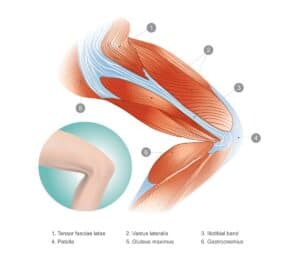Most people are aware of where the IT band is, but do not understand the signs and symptoms of IT band pain. This discomfort can actually be caused by another region of the body. Feeling pain in the outside of the knee, top of the lower part of the leg, or the mid outer thigh are common spots of irritation to the IT band. Understanding what the IT band is made up of and what the actions of this body part is, will help you to prevent an injury in your future.
The “IT band” is short for the iliotibial band. This means that it starts at the iliac crest (top of your pelvis), and connects all the way down (past the knee) to the tibia. Fun fact: the IT band is actually a tendon, connecting the muscles of the gluteus maximus and tensor fascia latae muscles, all the way down to the outer portion of the lower leg. Many people will see their “knee” is popping, however, when knowing where this band courses, you may save yourself from unnecessary exercises or further injury.
Now, knowing that the IT band is actually a tendon connecting the muscles of the glutes to the lower half of the leg, you will understand the actions and irritations of this area. The purpose of the gluteus maximus is to raise your leg backwards behind you and to the side of you. The purpose of the TFL is to aid the glutes in rotation of the leg and to raise the leg out to the side of you as well. This means that the IT band is wanting to move into these motions, and wants to help stabilize the hip and the knee with activity.
How does this body part get so irritated then? When performing lower body explosive exercises without proper lower body form, the IT band has to work extra hard to keep your body in proper alignment to avoid further injury. Keeping the hips even, knees going forward without falling/collapsing in, and preventing arch collapse in the foot are the best places to start when looking to prevent IT band injury or pain.
Preventing pain, or even healing current pain, can start with these exercises:
● Standing clamshells: standing with feet together, add a slight bend in the knees, raise 1 leg to the side
● Side lying hip abduction: lay on your side with bottom leg at a slight bend, keeping the top leg straight, raise the outside to the ceiling
● Banded bridges: laying on your back with knees bent and feet on the ground + squeezing your glutes, raise your core/pelvic girdle to the ceiling (small band above knees)
● Lateral banded walking: band above your knees, slight bend in the knees, taking steps to the side slightly wider than hip width
Understanding the way your body works is the best first step in preventing injury! Checking in with your physical therapist at Pure Physio for a lower extremity assessment is always helpful to ensure you are not lacking in strength or functionality when performing your sport or exercise!

